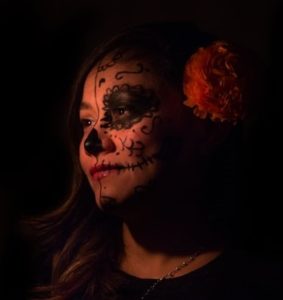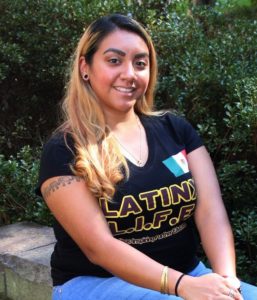 I grew up in a Mexican household speaking the language and eating the food, but most importantly, learning about all the different traditions the beautiful country has to offer. Living in the United States, we did not celebrate every holiday that was celebrated in Mexico, we did celebrate the bigger holidays and the most important traditions. One of the traditions that is dear to me and truly important to my family as well is Día de Muertos, Day of the Dead, which is soon to come on November 2nd.
I grew up in a Mexican household speaking the language and eating the food, but most importantly, learning about all the different traditions the beautiful country has to offer. Living in the United States, we did not celebrate every holiday that was celebrated in Mexico, we did celebrate the bigger holidays and the most important traditions. One of the traditions that is dear to me and truly important to my family as well is Día de Muertos, Day of the Dead, which is soon to come on November 2nd.
Many people who are not Mexican or close to this tradition ask me, “How can you worship the dead,” and go on to say, “isn’t that tradition calling evil in, calling the devil.” When I heard these comments, I laughed at the notion of people actually thinking we worshiped something “dark.” The traditions surrounding the Day of the Dead goes far beyond what everyone is used to seeing where my dad is from, Etla, Oaxaca, Mexico. In this valley, day of the dead is anxiously anticipated. It all starts about a week before November 2nd.
As I was growing up I remember my parents teaching us how to set the altar at home. A week before Día de Muertos we would place the altar with lots of food. My parents taught us that on the altar we were to put the fruits and foods our loved ones who had passed loved. There were traditional dishes like Mole Negro, (a traditional Oaxaca dish), Pan de muerto, (A Mexican bread specifically made for this day), hot chocolate, sweet potatoes covered in syrup, apples, oranges, pears, mandarins, peanuts, hazelnuts, a shot of mezcal, a beer, a cigarette, and a glass of water for their long journey to our home. Of course, we could not forget the papel picado, incense, candles, sugar skulls, fluorescent flowers and our loved ones’ pictures. This was something our family did every year, with the belief that our ancestors showed up to eat and feast at our table.
A few years ago, I had the opportunity to live to Oaxaca and by far, it was the best experience I have ever had in my life. I witnessed the different holidays and traditions and was able to sense the vibes and the passion that everyone had around holidays. One of the holidays I was so excited to experience was Día de Muertos. The holiday in Oaxaca was extremely different from what I had grown up celebrating.
Everyone, and I mean everyone, gets ready for Muertos a month in advance. The streets are full of color with cempazuchitl, which is the Mexican marigold. Starting a week before November 1st, everyone buys these flowers for their altars and tombstones. The cemetery gets full of life with these flowers. In my family, we all go together to the cemetery, either on October 31st or November 1st, to clean the tombstones of our past ones and decorate them with these amazing flowers. As we are doing clean tombstones and lay flowers, we play music they must have liked and we laugh and cry in their memory. We pray for their souls and hope they will join us later in the day for our celebration. Being in the cemetery in Mexico gave me peace and hope that in the end, everything will be okay.
In my dad’s town, and in the surrounding towns they do something called La Muerteada on November 1st. La Muerteada involves everyone getting dressed up and dancing until the morning of November 2nd. My dad says that years ago, it was traditional to dress up as skeletons, witches, old ladies and old men, the devil, and as the dead, in order to make fun of death. No one had to know who was dressed up as what, it was always a mystery. There used to be representacion del muerto, representation of the dead where the characters consist of the dead one, the widow, the orphans, the old ones, the foreman, the spiritualist, the doctor, the devil and death. All these characters go by houses making it funny by using names, which were usually the ones of the house owners. There are still some towns that do this play which portrays what happens when someone dies and uses humor in order to not take death so seriously. The whole reason for dancing dressed up all night long is the belief that those who are alive and the dead are still able to dance together. We believe that our loved ones are feasting and dancing with us for one night and it is amazing to feel that they are around us as we celebrate their lives.
Día de Muertos is so much more than just setting up an altar and painting our faces as skulls. It is a spiritual connection we have with our ancestors. It is a day to celebrate the life that they lived and remember them with stories and share our memories. Día de Muertos brings my family together to remember life is short and that we will all go to the same place when we die. It does not matter if you are rich or poor, if you are overbearing or humble, we will all leave this world with nothing. Like a Mexican song says, “Lo que pasó en este mundo,Nomás el recuerdo queda, Ya muerto voy a llevarme, Nomás un puño de tierra.”which translates, “What happened in this world, only the memory stays, when I am dead, I am going to take, only a fist of soil.”
The only things that one leaves behind are the memories that others have of you and which is how everyone will always remember you, which teaches us why it is important to be good to everyone and to treat others with respect and love.
Dedicated to my uncle Samuel Mendez who passed away Sunday, October 20, 2019. He taught us how to live life fully and love our traditions. Te voy a extrañar tío!
Esmeralda Mendez is Mexican-American. She is the proud daughter of immigrant parents and has Latinx roots. Esmeralda is a dancer, poet, and passionate young woman who is began her Masters in Social Work in the fall of 2019.


There are no comments
Add yours